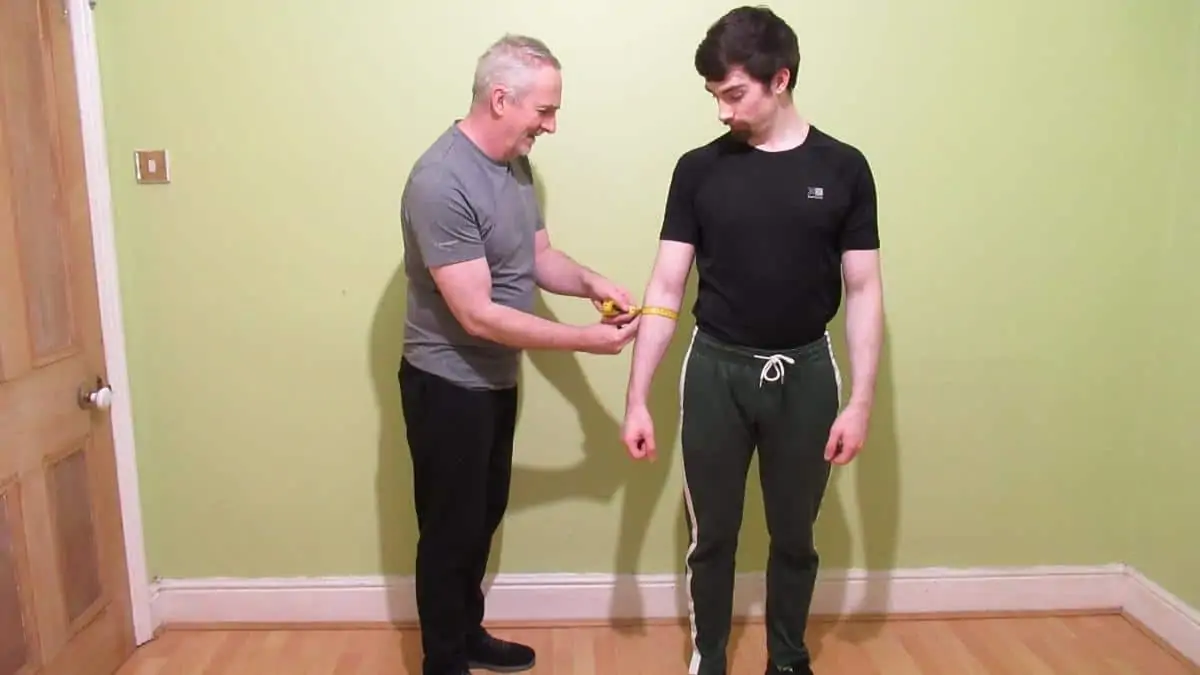Whether you want to discover how your muscularity stacks up with the average forearm size or whether you simply want to learn how to correctly measure your forearm circumference, this guide is for you.
We’ve drawn on real human studies as well as countless years of anatomy experience to teach you everything that you need to know about forearm measurements.
Related:
- Average bicep size
- Average wrist size for males
- Average calf size
- Average hip size
- Average shoulder width
What is the average forearm size in men?

So, how big are the average man’s forearms? Based on the research, the average male forearm is between 9.9 inches and 11.7 inches.
Why the range?
The average forearm circumference depends on the age of a man, his genetics, and his training status. For example, the men who had 9.9 inch forearms on average were elderly men from Japan (their average age was 77!) who had an average bodyweight of just 62kg. [1]
On the opposite end of the spectrum, the men with impressive 11.7 inch forearms were fitness competitors from Jordan. [2] Unlike the Japanese seniors, these men had more than 11kg extra lean body mass while likely also having a lower body fat percentage.
Plus, they were significantly taller, and taller people tend to have more bone mass, which, in turn, can support more muscle tissue.
Interestingly, once study on men from Saudi Arabia found that despite being 42 years old, the average forearm size was still 11.0 inches. [3]
This tells me that, as a natural lifter, you’re not going to put tons of size on your forearms since they’re already fairly well developed compared to other muscle groups due in large part to their daily usage.
Also consider, however, that 0.7 inches—the difference between the weight lifters and the middle-aged men—is still quite a lot of size when you look at it from an overall percentage. Remember, the forearms consist of bone and other tissue, too, so an inch of pure muscle can make a big difference in their appearance.
See how your size stacks up
- 11 inch forearms
- 12 inch forearms
- 13 inch forearms
- 14 inch forearms
- 15 inch forearms
- 16 inch forearms
- 19 inch forearms
- 20 inch forearms
What is the average forearm size in women?

What’s the average forearm circumference for a woman? Based on the available data, the average forearm size for a female is between 9.3 inches and 10.5 inches. [4]
As with the men, this is quite a range. And it largely depends on body weight. In the first study, the female participants had a right forearm measurement of 9.5 inches and a left forearm measurement of 9.3 inches.
This lends credence to the idea that simply going about your everyday activities will lead to healthy forearms.
Moreover, most people, being right-handed, will naturally favor that side of their body when lifting objects and doing work, so that side will also naturally grow more than the other.
So it’s little surprise that the ladies had a slight discrepancy in their measurements.
The women with 10.5 inch forearms were actually obese and thus had a much higher body weight than average. [5]
What is the average forearm length?
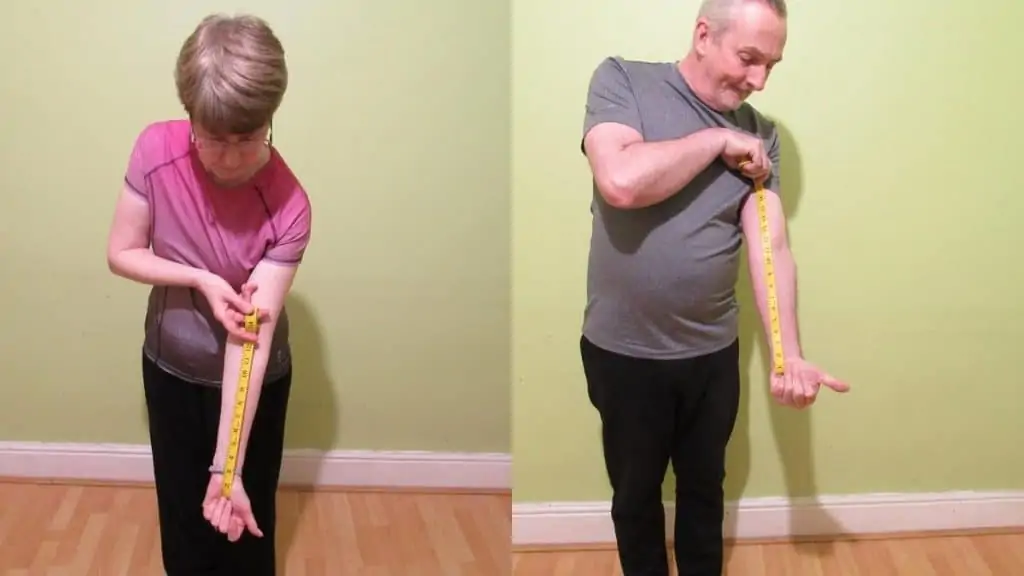
So, just how long is the average forearm? Based on European research of over 1500 participants in Lublin, Poland, the average forearm length in men is 25.4cm while the average length in women is 23.5cm. [6] These measurements were for the right forearm (the left was pretty similar)
What’s really interesting, though, is that although men had longer forearms on average, the female group actually recorded a higher measurement in the upper end of the range. The longest male forearm for the left arm was 30cm, but it was 33cm for the women.
The caveat to this is that there were more than double the amount of women in the study. But still, it seems like women have long forearms in general.
Crucially, the researchers noted that there was a correlation between height and the average forearm length. So, in general, the taller you are, the longer your forearms will be.
See Also: Average neck size│Average male chest size
How to measure your forearm circumference accurately

Here’s a step-by-step guide on how to measure forearm circumference accurately and avoid making mistakes.
- Remove clothing from around the forearm, as this can inflate the measurement.
- Ask the subject to place their forearm in a relaxed position by the side of their body. Their palms should be facing forwards.
- Loop the tape measure around the most muscular part of the forearm and record the measurement*.
- Take another 1-2 measurements and compare the numbers to verify your accuracy.
*You may have to move the tape measure around the forearm to find the thickest point. Also note that you shouldn’t make the tape measure overly tight or loose, as this can skew the results.
Can you change your forearm circumference?
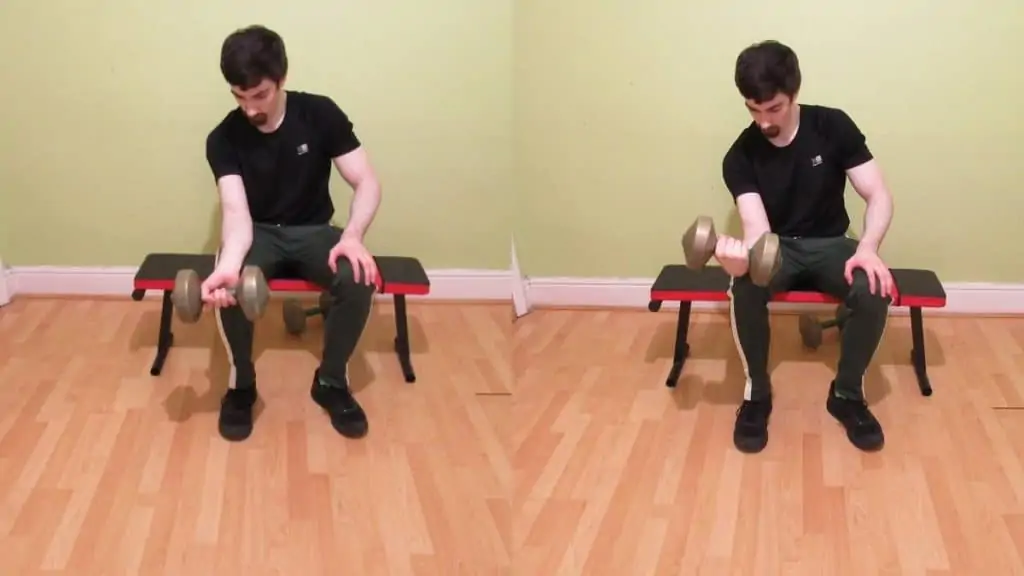
While the length of forearm bones is genetically determined (and so is muscle mass to an extent), there are certain things that you can do to alter your forearm circumference.
Our guide on how to get bigger forearms is a great place to start (if I do say so myself) if you’re looking to build muscle.
But, to give you a summary, yes, it’s totally possible to increase your forearm circumference by lifting weights and gaining extra body weight.
Just make sure to prioritize your recovery because, as many wise weight lifters have said, muscles grow outside the gym—not inside it.
FAQ
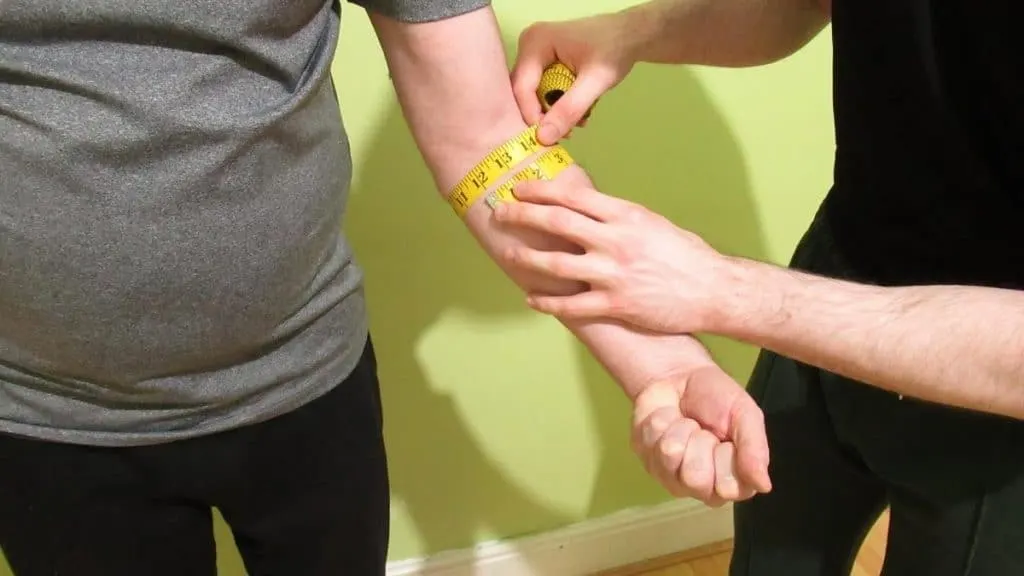
Where can I get a forearm size chart?
Since there’s no exact ratio between your height and forearm size, many of these average forearm size charts can actually be quite misleading.
But I’ve found a useful alternative. And best of all, it’s free.
The National Center for Biotechnology Information and other similar organizations make many scientific studies available for free. You can use their search functions to find research papers related to the “average forearm circumference” or something to that effect.
This is really helpful because these studies have nice data tables with all the measurements, heights, weights, ages, and other statistics of the participants that you need to know.
How long is a forearm on average?
The average female forearm length is 23.5cm, whereas the average forearm length in males was a bit higher at 25.4cm.
Should you account for body fat when taking a forearm measurement?
Yes, the more body fat that you have, the larger the forearm measurements you’ll naturally record. Luckily, you can take skinfold measurements with calipers to gauge what body fat percentage you have.
The good news is that most people’s forearms tend to stay relativity lean compared to the rest of their body. This is especially true for men.
Where on the limb do you measure your forearm circumference?
If you’re wondering where to measure your forearm circumference, always remember this: you want to measure around the thickest part of the muscle. This area might take several attempts to determine, but it definitely yields the most accurate measurements.
Do men have bigger forearms than women?
In terms of circumference, yes, men have considerably bigger forearms than women.
However, based on a Polish study of 1630 subjects, men and women have a very similar forearm lengths, although men still have slightly longer bones on average.
Read More: Average thigh size│Average waist size
Conclusion: Measuring your forearm circumference accurately
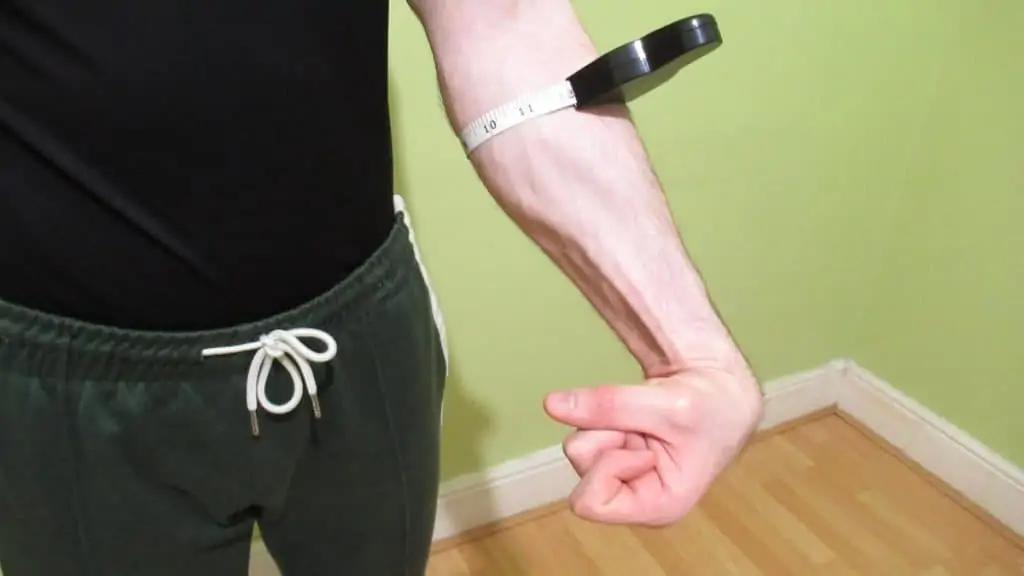
There are many sources online that discuss the average forearm size in males and females. However, much of this data is anecdotal. When you look at the research, you see a much smaller circumference range than when you look on forums, for example.
Men typically inflate their forearm measurement and also usually state their flexed circumference, whereas from what I can tell, women don’t really care to discuss their forearm size and are more concerned with their forearm length, if anything.
A key takeaway is that those who perform resistance training have a much higher average forearm circumference than those who don’t. Further, bodyweight correlates very highly with forearm size.
References
- Abe, T., Thiebaud, R. S., & Loenneke, J. P. (2016). Forearm muscle quality as a better indicator of physical performance than handgrip strength in older male ground golf players aged 70 to 89. Journal of Musculoskeletal and Neuronal Interactions, 16(4), 296–301. https://pubmed.ncbi.nlm.nih.gov/27973381/
- Kilani, H., & Abu-Eisheh, A. (2010). Optimum anthropometric criteria for ideal body composition related fitness. Sultan Qaboos University Medical Journal, 10(1), 74–79. https://europepmc.org/article/pmc/pmc3074666
- Alahmari, K. A., Silvian, S. P., Reddy, R. S., Kakaraparthi, V. N., Ahmad, I., & Alam, M. M. (2017). Hand grip strength determination for healthy males in Saudi Arabia: A study of the relationship with age, body mass index, hand length and forearm circumference using a hand-held dynamometer. Journal of International Medical Research, 45(2), 540–548. https://doi.org/10.1177/0300060516688976
- Abe, T., & Loenneke, J. P. (2015). Handgrip strength dominance is associated with difference in forearm muscle size. Journal of Physical Therapy Science, 27(7), 2147–2149. https://doi.org/10.1589/jpts.27.2147
- Polymeris, A., Papapetrou, P. D., & Katsoulis, G. (2014). An Average Body Circumference Can Be a Substitute for Body Mass Index in Women. Advances in Medicine, 2014, 1–6. https://doi.org/10.1155/2014/592642
- Zarzycka, N., & Załuska, S. (1989). [Measurements of the forearm i inhabitants of the Lublin region]. National Library of Medicine. https://pubmed.ncbi.nlm.nih.gov/2562693/

